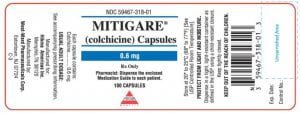Though it is always wise to balance allopurinol side effects against the benefits of safe uric acid, some reactions are too serious to tolerate.
Allopurinol hypersensitivity syndrome is a very serious, even fatal, side effect that affects a small percentage of the population.
Recent guidelines have recommended two steps to minimize allopurinol side effects.
Minimize Allopurinol Side Effects Guidelines
The 2012 American College Of Rheumatology gout guidelines recognize the importance of treating gout to lower uric acid to 5 mg/dL. This is an important safety issue for gout. Medically, the guidelines stress the importance of allopurinol or febuxostat (Uloric / Adenuric). Beyond the guidelines, the rheumatologists are keen to point out that allopurinol will be favored against Uloric for most gout patients on cost grounds.
Given the importance of allopurinol in gout treatment, the panel who wrote the guidelines considered measures to reduce the incidence of severe allopurinol hypersensitivity reactions, also called allopurinol hypersensitivity syndrome (AHS).
Minimize Genetic Allopurinol Side Effects
The panel considered inherited differences in the way people respond to drugs (pharmacogenetics) and the ability to screen for AHS. They recommend a specific gene, HLA–B*5801 should be tested for in high-risk groups prior to starting allopurinol.
High-risk groups are:
- Korean descent with chronic kidney disease of stage 3 or worse (i.e. Glomerular Filtration Rate less than 60).
- Han Chinese irrespective of kidney function
- Thai irrespective of kidney function
You should note that the recommendations are based on published studies. The inclusion of these three groups does not mean that other groups will not be affected – just that data is not available at the moment to extend the groups to other races. The panel recognized that white people did not fall into the high-risk category. They recommend alternative uric acid lowering treatment, such as febuxostat, where HLA-B*5801 test results are positive.
Minimize Chronic Kidney Disease & Allopurinol Side Effects
There has been a fairly common approach of reducing allopurinol dosage where gout patients have kidney problems. This was based on one study that looked at measuring creatinine clearance.
The gout guidelines panel do not recommend this approach, but they have adopted a recommendation for considering kidney function when setting the starting dose of allopurinol. This is related to their general goal of reducing the incidence of AHS.
The guideline states that the starting dose should never be higher than 100 mg per day for all gout patients. Where the patient also has chronic kidney disease of Stage 4 or 5, the maximum starting dose should be reduced to 50 mg per day. The dose should be increased every 2-5 weeks until uric acid is reduced to target level. Normally this is 5 mg/dL, but allowances may be made for kidney problems or other issues and the target relaxed to 6 mg/dL. There are no firm recommendations on limiting the dose other than to be guided by uric acid level. There is no need to limit dose because of kidney problems, but both patient and doctor must watch for side effects. The doctor should arrange regular kidney and liver function tests, and gout patients with chronic kidney disease should watch for any signs of rash.
Minimize Kidney Function & Allopurinol Side Effects
Recently, and presumably too late for the 2012 guidelines, a new investigation has looked at the relationship between allopurinol dosing and AHS.
In Starting dose is a risk factor for allopurinol hypersensitivity syndrome: a proposed safe starting dose of allopurinol, Stamp and colleagues compared allopurinol doses and estimated glomerular filtration rate (GFR). They found that most cases of AHS occurred when starting dose was more than 1.5 mg per unit of GFR. They conclude:
Our findings indicate that starting allopurinol at a dose of 1.5 mg per unit of estimated GFR may be associated with a reduced risk of AHS. In patients who tolerate allopurinol, the dose can be gradually increased to achieve the target serum urate level.
These findings suggest that gout patients with severe chronic kidney disease might benefit from a starting dose even lower than 50 mg per day to minimize allopurinol side effects. You should ask your rheumatologist about this if you suffer kidney problems.
Leave Minimize Allopurinol Side Effects to browse other Allopurinol Side Effects
Allopurinol Side Effects Related Topics
Please remember: to find more related pages that are relevant to you, use the search box near the top of every page.
Common Terms: allopurinol, kidney, Most Helpful Gout Pages
Other posts that include these terms:
- High Alkaline Foods for Gout Diet Menu
- Gout Foods Table for Vegetables
- Gout Food List for GoutPal Foodies
- Foods High in Uric Acid Chart
- Purine Rich Foods
- Does Alcohol Affect Gout?
- Colchicine For Gout
Please give your feedback
Did this page help you? If yes, please consider a small donation. Your donations help keep GoutPal's gout support services free for everyone.
If not, please tell me how I can improve it to help you more.
- YouTube
- The gout forums.










